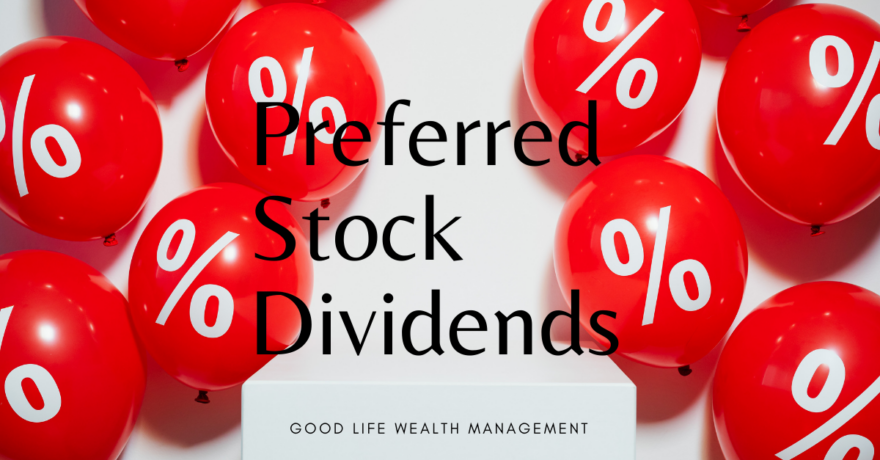As part of our Core and Satellite portfolio models, our investors have received Preferred Stock Dividends for several years. Preferred Stocks are different from Common Stock as they are a hybrid security which combines the features of a stock and a bond. Like a stock, preferreds trade on an exchange and pay a quarterly dividend. Like a bond, preferreds are issued at a Par Value ($25) and can be called or redeemed by the issuer in the future for $25.
If you’d like a primer on Preferred Stocks, check out my previous article, Preferred Stocks Belong In Your Portfolio. Or check out Forbes, What is Preferred Stock?
The Role of Preferreds
The preferreds we own have yields from 4-6% or more. Today, with the yield on 10-year Treasury Bonds around 1.25%, preferred stock dividends offer a nice rate of return compared to bonds but without all of the volatility of common stocks. And with the current high valuations on US Stocks, Preferred Stocks offer us an alternative that complements our stock and bond holdings. It’s a nice way to diversify our holdings, but preferreds remain a small, niche investment that most people have never owned.
Presently, our Premiere Wealth Portfolios have between 7-11.5% in Preferred Stocks. In our Defensive Managers Select portfolio, we have a 20% position in Preferred Stocks. Those are significant weights for a satellite position, but it remains a small piece of our overall allocation.
We buy a basket of individual Preferred Stocks. For each client, we will own a minimum of 5 and as many as 15 individual Preferred Stocks. As of today, our largest holdings include Capital One, Wells Fargo, Regions Financial, JP Morgan, and Brookfield Finance. Most preferreds are issues by financial companies, although there are some issued by real estate and utilities, too.
I prefer to own individual preferreds to have better control over the portfolio and keep costs down. Generally, I like to buy Exchange Traded Funds. And there is an ETF for preferreds: PFF from iShares. Two problems. First, the ETF owns many preferreds trading at a very large premium to Par. That means you would be buying a preferred at $27 that could be redeemed at $25 within 5 years. We have to look at the Yield to Call to understand this. Second, the ETF has an expense ratio of almost half a percent (0.46%), and that would reduce investors’ return. In a sector where the expected return is only 4-5%, that expense ratio would be a big drag on returns.
Managing Preferreds
Within our baskets of preferreds, we’ve had quite a few trades this summer. Generally, for most of my clients, we own preferreds in IRAs, since they create taxable income. In an IRA, we can trade without any capital gains impact. With yields falling this year, there has been a high demand for Preferred Stock Dividends. And this has pushed up the price of many Preferred Stocks. This is not a good time to just blindly buy any Preferred Stocks – many are very expensive.
So, we have been rotating from preferreds with higher prices to those with lower prices. In some cases, a Preferred with a high dividend payment actually has a low Yield to Call. If you are paying $27 for a preferred that is callable for $25, you are paying an 8% premium. And that premium will decline to the call date, creating a loss of capital that will eat into your total return. I am finding opportunities to improve our preferred stock dividends with some careful trades.
Trading and Upgrading
There are a couple of scenarios where we have placed trades to replace one preferred with another.
- Price comparison. Here are two preferreds with the same coupon of 4.45% and similar credit ratings and call dates. The Schwab (series J) is trading at $26.57, while Regions Financial (series E) is at $25.60. This is an opportunity to sell an expensive share and use the proceeds to buy more shares of the lower priced preferred.
- Same company, different series. Capital One’s series L has a coupon of 4.375% and the series N is at 4.25%. Both have the same call date of September 2026. There is a one-eighth of a percent difference in coupon. So, when the L’s were trading for 2.5% more than the N’s, that is too big of a difference. We sold the L’s and bought the N’s. Then this week, the prices swapped and we were able to sell the N’s and buy back the higher yield L’s for less. Many companies have multiple series of preferred stocks. Sometimes one is more expensive and the other is less expensive, for no logical reason. We’ve also swapped between the Goldman Sachs series C and D, which both have a 4% coupon.
- New issues. We can buy IPOs of Preferred Stocks. We’ve bought a new JP Morgan preferred at $25 this summer and it is now up to $25.56. Other times, we have been able to buy preferreds for below $25 for a few days after the IPO, when the issue was undersubscribed. We’ve bought shares of Regions Financial and Texas Capital Bancshares at a discount this way. Over a few weeks, new issues usually move to where similar preferreds are priced.
Long-Term Outlook
I’ve been looking at all types of income securities for the last 17 years. Not just Preferred Stocks, but Closed End Funds, MLPs, REITs, and individual corporate and municipal bonds. It’s a lot of time to manage individual securities correctly, and it takes skill and knowledge that takes years to develop.
I like the idea of Preferred Stock Dividends to add income to our portfolio models. And that’s the purpose behind our Alternatives sleeve to the portfolio: to seek investments with a better return than bonds, and lower correlation and volatility compared to stocks.
For now it’s working as I had hoped. What might change this? If we see the Federal Reserve start to raise interest rates and see the long-end of the yield curve move up, this would be negative for preferreds. That’s why this is a Satellite holding and not a Core. There may well come a day that we liquidate the preferreds for another asset class with better prospects. Even though we are buy and hold, long-term investors, by no means is the approach a purely passive portfolio. Rather than looking in the rear view mirror, we construct portfolios looking forward at the challenges we see facing markets today.
Have a question about Preferred Stock Dividends? Curious about your Retirement Income? Let’s talk about our portfolios and how they might work for you. Click Contact on the top of this page to get in touch!





